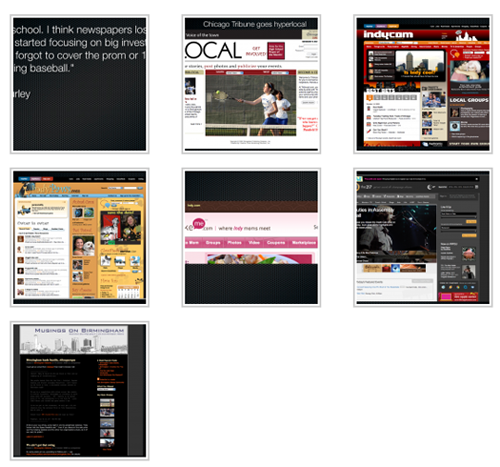place blogging and hyperlocal journalism
As Tim Lindgren (2005) pointed out in his Kairos article, "Blogging Places," place blogs are concerned with the "whereness" of daily life; Lindgren defined place blogging as "a genre of online writing that takes as one of its central concerns the relationship between identity and place" (n. p.). Throughout the article, Lindgren revealed that place blogging has a tendency to blur the distinctions between geophysical and metaphorical geographies. For place bloggers, where they write not only connects them to their physical communities but helps to construct a virtual community among other place bloggers. The digital neighborhood, in the case of place bloggers, begins within a literal neighborhood and moves outward. And like many digital neighborhoods, place bloggers often focus on what journalists call hyperlocal content.
Hyperlocalism is devoted to the stories, the news, and the ins and outs of a particular neighborhood, zip code, or group within a specific geographic region. Rob Curley, a Kansas native, helped to create LJWorld.com, an online version of Lawrence Kansas' newspaper, Lawrence Journal-World. The plan was simple: cover local news from a local perspective. Curley explained he doesn't think of himself as new media, rather he urged newspapers to get back to their roots: covering the community. In an interview with Fast Company magazine (Salter, 2006), Curley says, "I'm old school. I think newspapers lost their way and started focusing on big investigative stuff and forgot to cover the prom or 10-year-olds playing baseball” (n.p.). On his blog, Curley (2008) applauded the Las Vegas Sun's coverage of the Monte Carlo hotel fire as it happened: The coverage began with a live blog, continued with pictures, and then included a historical overview of the hotel. As events unfolded, the Sun's website covered them in real time, continuously updating content, and provided ways for readers to upload their own videos and photos of the event. Curley's hyperlocal philosophy encourages local outlets to own the stories happening in their area. Curley (2008) explained that you can't "outCNN CNN" but you shouldn't let them OutLawrence, OutNaples, Outinsertyourtownnamehere you (n.p.). The philosophy has caught on with sites like Triblocal.com, sponsored by the Chicago Tribune which asks readers to become contributors by sharing "news the way [they] define it – photos, opinions, upcoming events, meeting announcements, helpful hints" (Frequently Asked Questions). Readers select the specific suburb or Chicagoland area such as Tinley Park, Lemont, Geneva, Batavia, Glen Elyn, etc. Each area gets localized coverage including top stories, daily photos, and highlighted events. Newspapers around the country are reevaluating their approaches to news coverage. The Indianapolis Star's local media site, IndyStar.com, also sponsors IndyMoms and Indypets.

But it is not just news organizations getting in on the hyperlocal act. Sites like yelp, outside.in, and EveryBlock attempt to connect users to their collective identities through the news, people, and places in their neighborhoods and communities. Each site discussed in this text focuses on hyperlocal content helping users construct their collective identities through place.


June